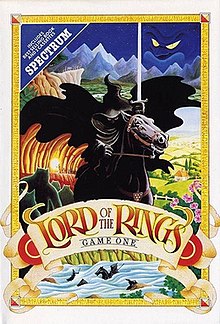Lord of the Rings: Game One
| Lord of the Rings: Game One | |
|---|---|
 European cover art | |
| Developer(s) | Beam Software |
| Publisher(s) | Melbourne House |
| Designer(s) | Philip Mitchell |
| Platform(s) | ZX Spectrum, Commodore 64, Amstrad CPC, Amstrad PCW, BBC Micro, Apple II, Macintosh, MS-DOS.[2] |
| Release | 1985[1] |
| Genre(s) | Interactive fiction |
| Mode(s) | Single-player |
Lord of the Rings: Game One (released in North America as The Fellowship of the Ring: A Software Adventure) is a video game released in 1985 and based on the book The Fellowship of the Ring, by J. R. R. Tolkien. It was the follow-up to the 1982 game The Hobbit, but did not reach the same level of critical success as its predecessor. It's generally considered inferior by the gaming community, with many[who?] complaining about the removal of the real-time aspects and complex AI patterns of the previous game, and puzzles that lacked coherent solutions. To promote the game, Melbourne House commissioned hologram picture of a Nazgûl from a company called Holographix.[3] It was available to purchase from Melbourne House directly using an order form on the instruction booklet included with the game.[4] A sequel, Shadows of Mordor: Game Two of Lord of the Rings, was released in 1987.
Reception
[edit]| Publication | Award |
|---|---|
| Crash | Crash Smash |
| Sinclair User | SU Classic |
| Your Sinclair | Megagame |
Macworld reviewed the Macintosh versions of The Hobbit, The Fellowship of the Ring and The Shadows of Mordor simultaneously, criticizing The Hobbit, calling it "particularly clumsy" as it is "handicapped by a 400-word input vocabulary" as opposed to the latter two games' 800 words. Macworld calls The Fellowship of the Ring "particularly intricate" and recommends it as an entry point to the series as opposed to The Hobbit. Macworld praises The Hobbit's graphics, but states that in The Fellowship of the Ring and The Shadows of Mordor the art adds little to the games' overall appeal. Furthermore, Macworld heralds the three games as "literate and faithful in spirit to original books", but criticizes the dated and "rigid" nature of the text-adventure format.[5]
According to Beam Software, the game was a commercial success.[6]
References
[edit]- ^ "The Lord of the Rings - An exclusive preview of the new adventure based on Tolkien's Middle Earth trilogy". Computer and Video Games. No. October 1985. September 1985. pp. 32–35.
The long awaited sequel, Lord of the Rings, is nearing completion
- ^ Tolkien computer games pages
- ^ "From Faluvian Empire to Sculpting in Light". Crash. No. October 1985. September 1985. pp. 36–38.
- ^ "The Lord of the Rings: Game One". Manual: 27–28. 1985.
- ^ McCandless, Keith (May 1989). "New Hobbits For Old". Macworld. Mac Publishing. p. 209.
- ^ "Beam Software History". beam.com.au. Archived from the original on June 7, 1997. Retrieved March 17, 2022.
External links
[edit]- 1980s interactive fiction
- 1985 video games
- Adventure games
- Amstrad CPC games
- Amstrad PCW games
- Apple II games
- BBC Micro and Acorn Electron games
- Beam Software games
- Classic Mac OS games
- Commodore 64 games
- DOS games
- Interactive fiction based on works
- Single-player video games
- Video games based on Middle-earth
- Video games developed in Australia
- ZX Spectrum games

